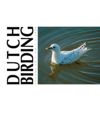Dutch Birding volume 30 (2008) no 3

30 years Dutch Birding, part 3: 1989-93
This paper describes the third five-year period of Dutch Birding and the DBA which, by now, had established a firm position in the Netherlands as well as abroad and had reached many of the goals set out at the foundation in 1979. In this period, Dutch Birding was transformed from a quarterly to a bimonthly journal, starting with five issues in 1990 and six from 1991 onwards. Besides, a larger format was introduced with a new cover and lay-out, still in use today. For a year before Dutch Birding became bimonthly, a Dutch-language monthly newsletter was published. In these five years, interesting papers were published on identification and other subjects, including four on taxa new to science (all treated as subspecies). The DBA started several new activities, such as producing identification guides in co-operation with publishers, organizing the first Euro Bird Week (which led to the foundation of the Association of European Rarities Committees AERC) and promoting the Dutch Birding Travel Reports Service. Other birders' activities which received a varying degree of support from the DBA included organizing pelagic trips and, most importantly, establishing the first pager groups in 1990 to share news of rare birds instantly. The DBA also started to co-operate with other ornithological societies and organizations, eg, to monitor the occurrence of scarce migrant and breeding species. In 1989, the birdline became semi-commercial, making news much easier available and generating income to improve the quality of Dutch Birding (for more pages and more colour photographs) and refund some of the volunteer work. Some of the rarest or most wanted species ever were found in these five years, a few still being major 'blockers'. New taxa were, chronologically, Semipalmated Sandpiper Calidris pusilla, Bridled Tern Onychoprion anaethetus, Sharp-tailed Sandpiper C acuminata and Wallcreeper Tichodroma muraria in 1989 (an American Golden Plover Pluvialis dominica turned from the first into the second when a skin collected in 1900 was identified in 1990); Blyth's Reed Warbler Acrocephalus dumetorum and Two-barred Warbler Phylloscopus plumbeitarsus in 1990 (both trapped); Great Knot C tenuirostris, Sandhill Crane Grus canadensis (the 'Shetland bird') and Pallas's Grasshopper Warbler Locustella certhiola (trapped) in 1991; Falcated Duck Anas falcata (the first certainly not wearing a ring and free of suspicious damages), Booted Eagle Aquila pennata and 'soft-plumaged petrel' Pterodroma (deserta)/feae/madeira/mollis in 1992 (the first Baltic Gull Larus fuscus fuscus was later revised and rejected); and Laughing Gull L atricilla in 1993. An 'isabelline shrike' Lanius arenarius/isabellinus/phoenicuroides in 1993 was considered the first until another photographed in 1985 was identified almost 10 years later. The same happened with a Balearic Woodchat Shrike L senator badius in 1993 which became the second when another was identified from a 1983 photograph. Other notable records concerned, for instance, the Wallcreeper returning for its second winter in 1990/91, the first twitchable Ivory Gull Pagophila eburnea (1990; second record), the first breeding of Melodious Warbler Hippolais polyglotta (1990), two wintering Olive-backed Pipits Anthus hodgsoni (1991), the first twitchable Ross's Gull Rhodostethia rosea (1992; third record), a small influx of Snowy Owls Bubo scandiacus (three) in spring 1992, and a Black-faced Bunting Emberiza spodocephala (1993; trapped). At the end of 1993, two birders (Klaas Eigenhuis and Gerard Steinhaus) shared the number one twitchers' position with 379 species (see table 2).
G J (Hans) ter Haar, Hollandse Hout 127, 8244 GD Lelystad, Nederland
(hterhaar planet.nl)
planet.nl)
terug






